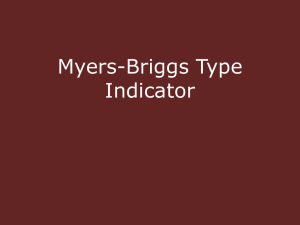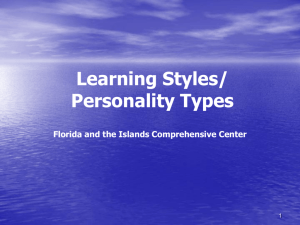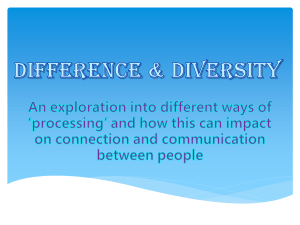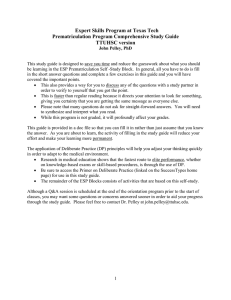Cognitive Style “Types” Myers-Briggs Type Indicator Working with different types 15.301 Managerial Psychology
advertisement
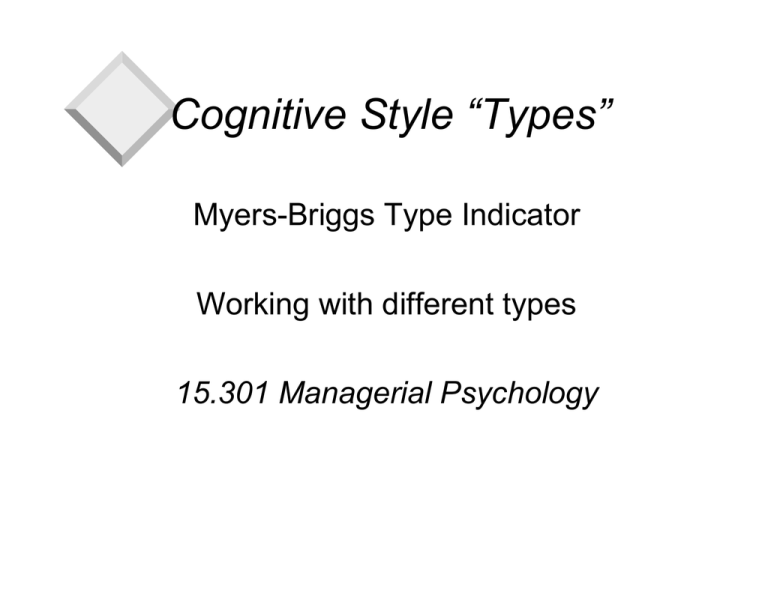
Cognitive Style “Types” Myers-Briggs Type Indicator Working with different types 15.301 Managerial Psychology Psychological Types Myers-Briggs Type Indicator Motivation - people having consistently different preferences (styles) in perception and judgment History and popularity - most frequently used personality test in US industry Limitation - widely criticized by academics Takeaway – Everyone has all eight skills, but in different amounts – used for insight and expansion of possibilities, not to label yourself or others in ways that limit growth 4 Basic Preferences or Styles Extraversion vs. Introversion (not shyness): outer world of people and things, energy generated from others vs. self-contained inner world of concepts and ideas Sensing vs. INtuitive: perception bottom-up through the senses vs. indirectly by making associations and models Thinking vs. Feeling: judgments made intellectually of true and false vs. personally valued and not-valued Judgment vs. Perception: drawing conclusions and acting on them easily, output and action focus vs. decide hesitantly with flexibility and focus on diagnosis Managing People (E vs. I) Extraversion Enjoys stimulation and variety MBWA Open-door Meetings used Communication stressed Introversion Easily overstimulated Self-contained Organized One-at-a-time Leaves others in the dark Acquiring Information (S vs. N) Sensing Matter-of-fact Empirical/practical Dislike fuzzy problems Specialist/functional perspective Present oriented INtuitive Generating ideas Enjoys new jobs Insight into complex problems Gestalt (top-down) perspective Future oriented Making Judgments (T vs. F) Thinking Tough-minded Analytic, quantitative Clear criteria Impersonal, detached Task-oriented Correct-incorrect Feeling Value-centered People-oriented personal perspective Warmth, overcommitted Good-bad Establishing Goals (J vs. P) Judging Output-oriented “Time is money” Prefer action to analysis Implementation oriented Perceiving Take on many projects Overload “Look before leap” Emphasize diagnosis The 2 Major Dimensions Thinking logical, scientific, impersonal, distant, rational Sensing ST specialist, factual, realist, practical, SF conventional NT Intuition NF generalist, inventive, idealistic, holistic, future-oriented Feeling artistic, passionate, personal, ethical 4 Types in 2 Dimensions ST SF Practical Social NF NT Idealistic Theoretic al Perceive: Facts Facts Possibilities Possibilities Judge by: Analysis Liking Analysis Liking Strategic Skills as: Operational Operational Strategic technical people people technical problemproblemproblemproblemdefiners definers solvers solvers Science Teaching Sales Found in: Accounting Entrepren. Writing Service Law Gen. Pract. Psychiatry Cardiology Surgery Where You Find Them At Work ST (%) SF(%) NF(%) NT(%) Liberal Arts students 24 17 28 31 Science students 12 5 26 57 Mathematicians 4 0 32 64 Writers 12 0 65 23 Architects 0 0 50 50 Sales/customer rel. 11 81 8 0 College grads, industry hired 40 10 8 42 Wharton undergrads 51 21 10 18 The Ideal Organization Kilmann & Mitroff ST: clear jobs, clear hierarchy, physical space, individual serves goals of organization (realistic, often economic) NT: broad issues such as equitable pay and efficiency, individual serves the intellectual concept of organization SF: good human relations, human qualities of workers, specific individuals, realistic NF: global human goals such as “serving humanity,” organization exists to serve people, idealistic, flexible, few rules, decentralized Problem Definitions By Style Case: A building construction company expanded into highway construction and was plagued by mixups, cost overruns, and other problems ST: problems are the delays and costs, inefficiencies in purchasing dep’t, lack of material resources NT: lack of planning and coordination, communication failure, new complexity requires organization design SF: frustration, lack of cooperation and understanding, climate of blame among departments NF: company image, not fulfilling global goals or adhering to our identity, strategy doesn’t fit the needs of social system An Example: IT Support Imagine building an information system to serve different types: Thinking types like tables of numbers, analyze and discard alternatives quickly, work methodically Feeling types like graphs and pictures, redefine the problem and their method as they go, consider several alternatives together Sensing types need complete exposure to all the data and personal experience (case-based gut feel) before looking at math or verbal (theory) models Intuitive types need to look at the relationships among the data and jump around in the data Working With the Types People believe everyone thinks the same way. If we disagree, you’re uninformed or stupid! Es: Is are uninterested or withholding information. (Is are processing internally) Is: Es are inconsistent (Es are thinking aloud) Js: Ps are procrastinating and unreliable (Ps try to keep options open) Ps: Js are rigid and controlling (Js are structuring and scheduling) Working With the Types Preferences and style tend to become strengths and weaknesses: Are you a prisoner of your type? When would it be better to build on strengths vs. exercise your recessive mode? When should we form homogenous groups vs. heterogeneous groups? Types need each other, e.g., strategic planning without operational content is empty, technical content without people content is not persuasive Questions for Reflection What distinctive style, preferences, and beliefs do you bring to your work and personal life? What has happened when you dealt with people of contrasting style and beliefs? How might it matter if differences are due to personality, situation, or culture?

